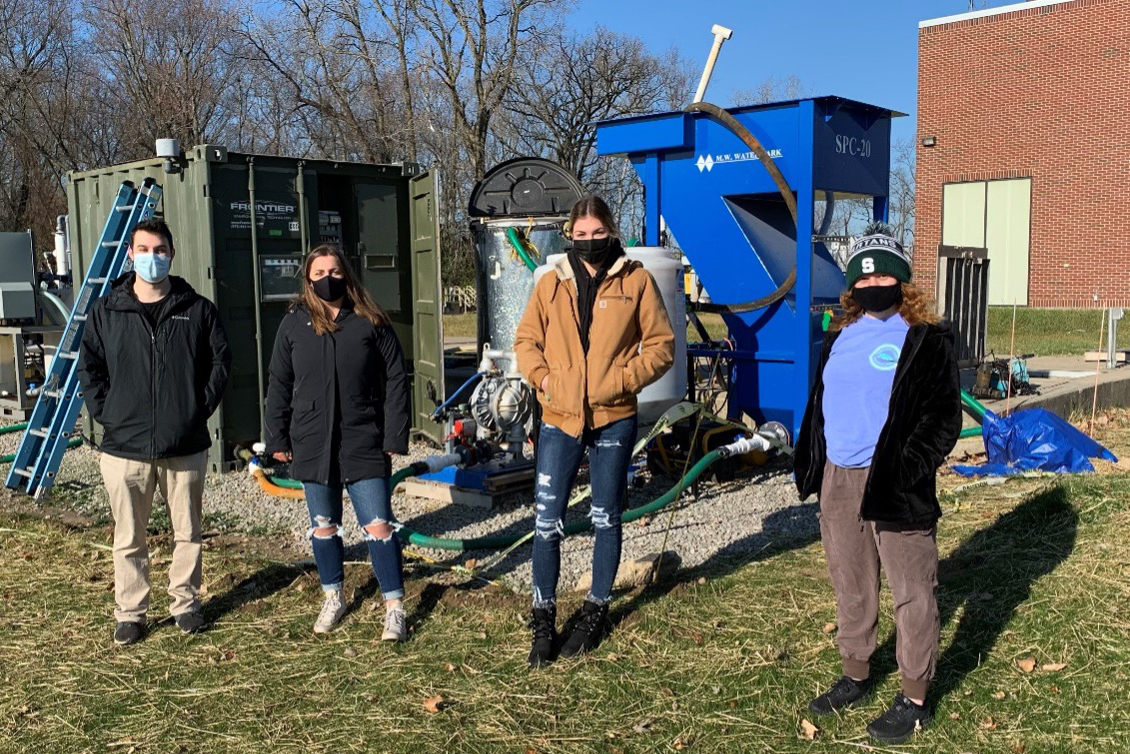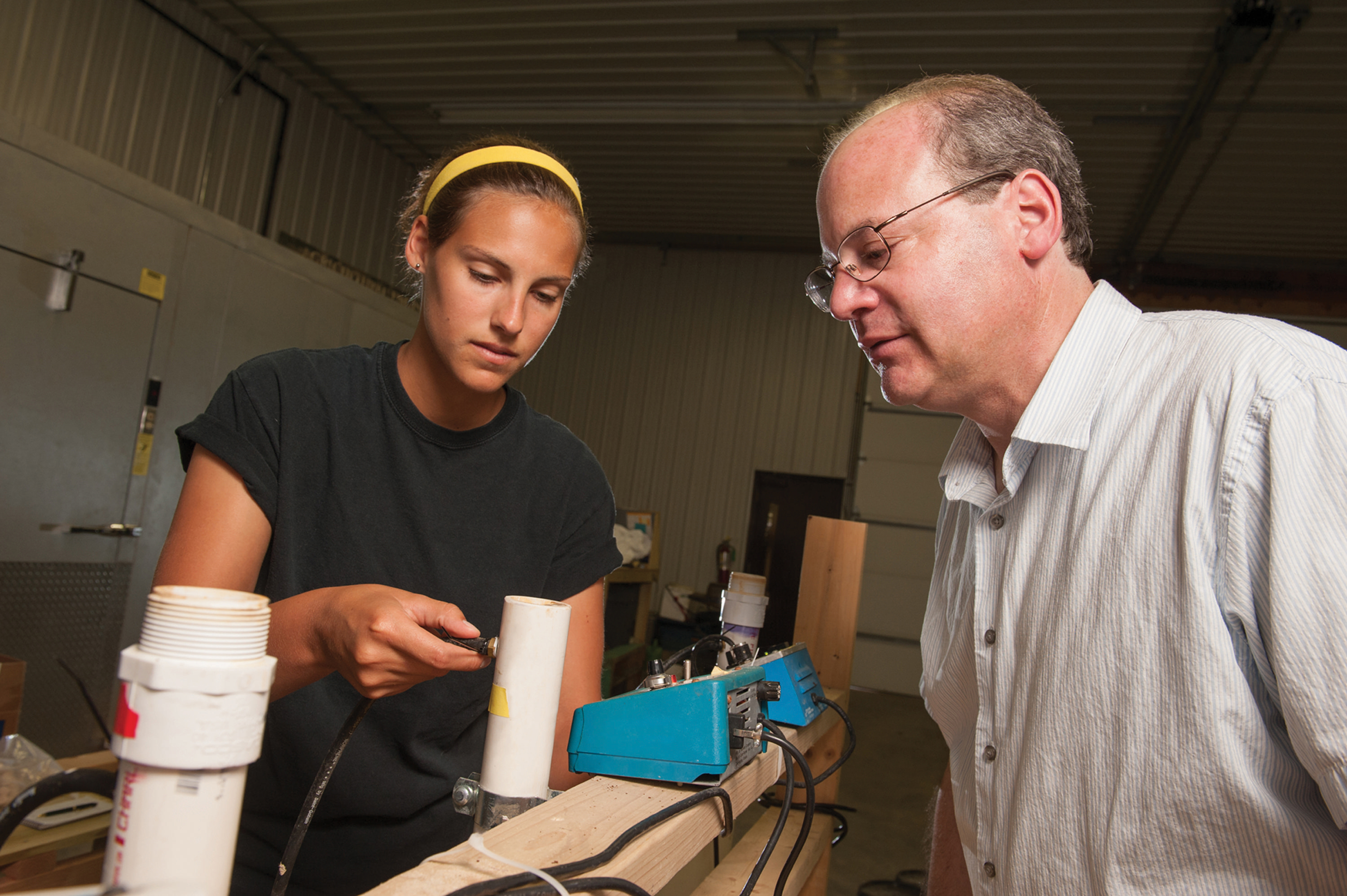Scale-up facilities increase opportunities for MSU researchers
Investments have had significant impacts on MSU biosystems engineering researchers, but additional support in water research and smart agriculture is key for continued growth.

Infrastructure investments in the Michigan State University (MSU) Department of Biosystems and Agricultural and Engineering (BAE) have helped faculty members elevate their research profiles, serve stakeholder needs and provide hands-on learning.
“Facility upgrades are important because they increase our ability to attract grant funding to do unique work, but also our ability to do that unique work,” said Bradley Marks, BAE chair and professor. “It’s that translational work of testing and scaling up lab research to the real world in order to validate technologies and solutions.”
One facility upgrade that has had a significant impact on the department is the Biosafety Level-2 Pilot Plant, a food processing/engineering facility in Farrall Hall. Marks manages the plant, which supports research programs across multiple departments.
“The Biosafety Level-2 Pilot Plant has translated into over $20 million of external grant support that were acquired largely because we had the capacity to do scale-up work on food safety,” Marks said. “Having capabilities that our peer institutions do not have positions us to carry out research projects that give us a competitive edge in going after external grant support.”
The MSU Anaerobic Digestion Research and Education Center (ADREC), which analyzes and executes processes to turn organic waste into energy, is another investment that has proved beneficial.
“From doing bench-scale laboratory research, all the way to the South Campus Anaerobic Digester that's producing power for campus from organic waste (including food waste) — having that bridge to enable scale-up work, empowering the faculty members to use that equipment and those facilities to partner with industry to take their research to the next level — is extremely important,” Marks said.
Wei Liao, BAE professor and ADREC director. said that scale-up facilities such as ADREC help MSU stand out nationally and internationally.
“Whenever any interested people search for anything related to anaerobic digestion, and organic waste, MSU is one of the first places they go to,” he said.
High-quality facilities help increase collaboration
Future investments, similar those made for the Biosafety Level-2 Pilot Plant and ADREC, are needed to aid BAE in expanding its research, education and outreach efforts.

Water research is a major priority area for the department.
“We have 10 BAE faculty members doing really important work on water. Currently, they’re doing scale-up work in multiple locations on campus,” Marks said. “Having some consolidation where we would have the capabilities to advance the work that multiple researchers are focusing on — water quantity management, water quality, and resource recovery — would better position us as a leader in this field on campus and nationally.”
Liao manages a newer water research facility, a pilot wastewater treatment/utilization plant located on the northwest side of MSU’s campus. The facility, a partnership with the City of East Lansing, has attracted the attention of the U.S. Department of Agriculture (USDA), National Science Foundation (NSF) the U.S. Army, and various companies. Liao is working with the U.S. Army on a project to develop wastewater treatment for small military bases.
“Without this facility, the U.S. Army, USDA, and companies wouldn’t have come to us. We wouldn’t have more than $2 million in research investments that we do,” Liao said. “Lab work is important. However, it's not enough to push research to the level where we can convince funding agencies, stakeholders, or other key partners to say, ‘We see the promise in this work. We see the future. We want to invest.’”
Improved space for more efficient water research
Steven Safferman, BAE associate professor, works with multiple stakeholders for his research on water quality, including: the Michigan Department of Environment, Great Lakes and Energy (EGLE),the Great Lakes Water Authority, and a number of private companies and entrepreneurs. Along with his students, he helps these groups analyze and implement ways to minimize, reduce, and recover nutrients from wastewater.

“A lot of my group’s work is directly supporting stakeholders on economical, safe handling of their waste materials, and possibly recovery of the resources,” Safferman said.
His group’s research has impacts in Michigan and beyond, but they often face obstacles conducting it in their current spaces.
For small-scale work, Safferman’s team uses an indoor lab where the equipment is functional, but outdated. Newer, updated equipment would enhance BAE’s capability to test water quality and resource recovery technologies.
For larger-scale work, Safferman and his students work in the annex behind Farrall Hall. The annex, which resembles a large barn, lacks key infrastructure for some of the analytical work that needs to occur alongside the scale-up testing.
“Any sort of improved space would elevate our research capabilities, improve efficiency, while simultaneously ensuring the safety, convenience, and comfort of the students,” Safferman said.
With two small lab spaces, organizing experiments, equipment, data, and schedules is more difficult.
“Safety and data quality go together,” Safferman said. “With the current condition of our research spaces, we're going to get more data that don’t meet our quality assurance, quality control standards.”
Investments for the future of agriculture
Safferman shares the Farrall Hall annex with Renfu Lu, BAE adjunct professor and agricultural engineer with the USDA Agricultural Research Service (ARS). The building provides Lu with ample room to test large-scale smart agricultural technologies. Smart agriculture, or employing digital technologies for use in agricultural operations, is another priority area for BAE.
“Most of the buildings don't have the spaciousness the annex has in terms of vertical space and the floor space,” Lu said.
A robotic apple harvester and apple infield sorting machine, which expedites the process of sorting apples during harvest though the use of imaging technology, are among the technologies Lu and his research group have developed and tested in the annex.
They’ve also built a simulated orchard environment in the annex to properly test and evaluate the machine’s ability to pick and sort apples prior to going into to the field.
“We used some artificial trees, which mimic different apple trees in terms of their branches and height,” Liu said. “We also use different light settings, which allows us to mimic different kind of weather conditions: bright sky, cloudy sky, or overcast sky. We can also change the light angles from the morning to the afternoon.”
The annex provides Lu with the necessary room to test his machines, but in order for his program to grow, designated research space is important.
“The annex is not a research lab space. It looks more like a temporary working space for research,” he said. “Ideally, we would like to have a lab with a bench, open floor space, and a pretty high ceiling to continue to build our machines and work on smart ag projects. If we really want to turn the annex into a fully-functioning pilot-scale lab, a lot of improvements are still needed.”
Lu also has concerns about security, safety and functionality in the annex.
“A large, open space is difficult to control. The kind of thing that concerns me,” Lu said. “We also need to have a controlled environment when it comes to temperature, which would mean adding air conditioning.”
USDA-ARS and BAE are preparing to hire a second smart agriculture researcher to join Lu, who says the field is a worthy investment.
“It's kind of an exciting time for the smart ag researcher. I really hope that MSU, eventually, will be able to put more resources into this area.
Marks agrees.
“Michigan has a huge specialty crops industry and extremely diverse agriculture,” he said. “We need to elevate our game to provide the services we aspire to provide through our research and outreach programs in smart agriculture — and upgrading our facilities is a critical part of making that possible.”
Achieving results that make an impact
Scale-up facilities help BAE faculty provide more informed recommendations to stakeholders.

“Pilot plants and testing spaces allow us to implement technologies that we know are working to a certain degree. This large-scale work makes our department unique, and makes me more confident in my work, especially when I talk to stakeholders,” Liao said. “For example, when I talk to farmers, farmers don't care too much about what you're doing in the lab. They care about, ‘if you put this on my farm, what's the outcome?’”
Marks said that this type of research is at BAE’s core.
“In the DNA of our department, broadly, is the translation business: taking the basic understanding of the sciences and the technologies and scaling them up and translating them to practice, so we have a direct impact on our stakeholders,” he said. “These kinds of capabilities to do pilot-scale work, in all of our areas of our mission, are critically important to ensure our status as a premier program in our field.”
Investments in facilities have already shown dividends for the department. Continued support would increase BAE’s ability to make a difference in water research, smart agriculture, and other key priority areas, said Marks.
“To be the best, you need capabilities to do something unique and something impactful,” he said.



 Print
Print Email
Email





